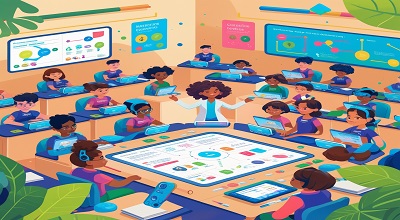Smart Classroom Tools
Smart Classroom Tools: The integration of technology in education has revolutionized traditional teaching methods. The latest Smart classroom tools enhance learning experiences by making them interactive, engaging, and personalized. These tools include hardware and software solutions that facilitate digital learning, collaboration, and real-time feedback.
With advancements in artificial intelligence (AI), virtual reality (VR), and cloud computing, smart classrooms are becoming more efficient and accessible. This article explores the latest smart classroom tools, their benefits, and real-world examples.
Benefits of Smart Classroom Tools
Smart classroom tools offer numerous advantages:
- Enhanced Engagement: Interactive tools like gamification and VR make learning fun.
- Personalized Learning: AI-driven platforms adapt to individual student needs.
- Efficient Assessment: Automated grading saves teachers time.
- Collaboration: Cloud-based tools enable real-time teamwork.
- Accessibility: Digital resources are available anytime, anywhere.
Latest Smart Classroom Tools with Examples
1. Interactive Whiteboards
Interactive whiteboards replace traditional chalkboards with touch-sensitive displays.
Examples:
- SMART Board – Allows teachers to write, draw, and display multimedia content.
- Promethean ActivPanel – Supports multi-touch and integrates with learning apps.
2. Learning Management Systems (LMS)
LMS platforms help manage course content, assignments, and assessments.
Examples:
- Google Classroom – Free, cloud-based LMS for assignments and grading.
- Canvas – Offers advanced analytics and third-party integrations.
3. AI-Powered Educational Assistants
AI chatbots and tutors provide instant help to students.
Examples:
- IBM Watson Tutor – Offers personalized learning recommendations.
- Squirrel AI – Adapts lessons based on student performance.
4. Virtual and Augmented Reality (VR/AR)
VR/AR creates immersive learning experiences.
Examples:
- Google Expeditions – Virtual field trips to historical sites.
- zSpace – AR-based STEM learning.
5. Gamification Platforms
Gamification makes learning competitive and fun.
Examples:
- Kahoot! – Quiz-based learning games.
- Classcraft – Turns lessons into role-playing adventures.
6. Collaborative Learning Tools
These tools enable group projects and discussions.
Examples:
- Padlet – Digital bulletin board for brainstorming.
- Microsoft Teams for Education – Video calls and file sharing.
7. Adaptive Learning Software
Adjusts content based on student progress.
Examples:
- DreamBox – Math lessons tailored to skill level.
- Knewton Alta – Personalized course materials.
8. Cloud-Based Classroom Solutions
Stores and shares resources online.
Examples:
- OneDrive for Education – Secure cloud storage.
- Blackboard Collaborate – Virtual classroom with live sessions.
9. Automated Grading Systems
Reduces manual grading workload.
Examples:
- Gradescope – AI-assisted grading for essays and coding.
- Turnitin – Checks plagiarism and provides feedback.
10. Student Response Systems
Real-time polling and quizzes.
Examples:
- Mentimeter – Interactive presentations.
- Poll Everywhere – Live audience feedback.
How to Choose the Right Smart Classroom Tools?
Consider:
- Budget (Free vs. Paid)
- Compatibility (Works with existing systems?)
- Ease of Use (Teacher and student-friendly)
- Scalability (Can it grow with your institution?)
Future Trends in Smart Classroom Technology
- AI-Driven Personalization
- Blockchain for Secure Credentials
- 5G-Enabled Classrooms
- Holographic Teaching Assistants
Challenges and Solutions
- Challenge: High costs. Solution: Seek grants and subsidies.
- Challenge: Tech resistance. Solution: Teacher training programs.
Conclusion
Smart classroom tools are transforming education by making it more interactive, efficient, and personalized. By adopting the latest technologies, educators can enhance student engagement and learning outcomes.
FAQs
1. What are the best free smart classroom tools?
- Google Classroom
- Kahoot!
- Padlet
2. How does AI help in smart classrooms?
AI personalizes learning, automates grading, and provides tutoring.
3. Are VR classrooms effective?
Yes, VR improves engagement and retention through immersive experiences.
4. What is the biggest challenge in adopting smart classroom tool?
Cost and teacher training are common hurdles.
5. Can smart classroom tool replace teachers?
No, they enhance teaching but cannot replace human educators.
Free Here: Merge Super Speedo APK
